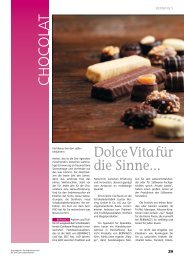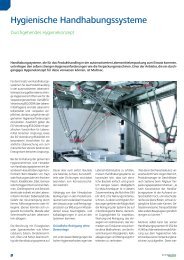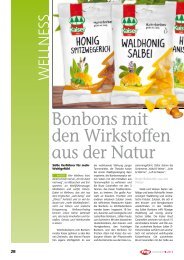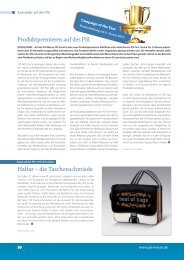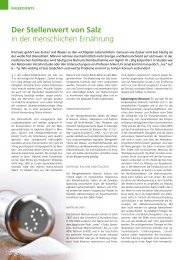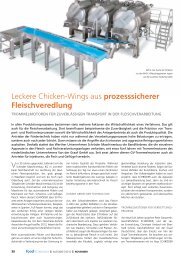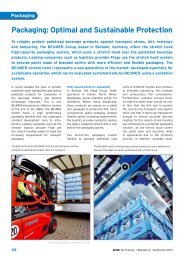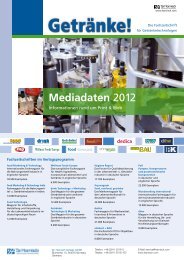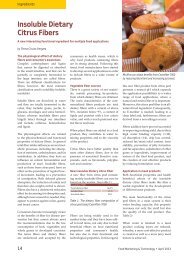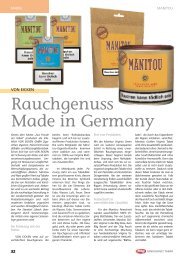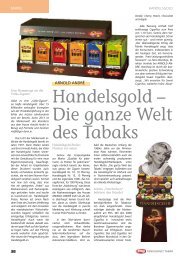PDF (986 KB) - Dr. Harnisch Verlag
PDF (986 KB) - Dr. Harnisch Verlag
PDF (986 KB) - Dr. Harnisch Verlag
Create successful ePaper yourself
Turn your PDF publications into a flip-book with our unique Google optimized e-Paper software.
Wellness Foods Europe Dairy products<br />
Low fat yet rich<br />
in texture,<br />
Greek yoghurt<br />
proves irresistible<br />
to consumers<br />
The phenomenal rise of Greek yoghurt<br />
in the US looks set to cross the Atlantic as<br />
more and more in Europe realise the potential<br />
of this humble pot that packs a punch.<br />
Rudy Wouters, Vice President BENEO-<br />
Technology Center discusses the market for<br />
Greek yoghurt in Europe and how functional<br />
ingredients, such as chicory root derived dietary<br />
fibre and rice starch can help food producers<br />
make the most of this trend.<br />
To give an idea of the speed of expansion experienced<br />
in the US, “Greek yoghurt brands<br />
such as Chobani and Fage have captured<br />
market share more quickly than almost any<br />
segment in a major food category ever (13<br />
points in the past 3 years). To put this in perspective,<br />
this is more than energy drinks have<br />
captured of carbonated soft drinks in the<br />
past 6 years.” i In fact, leading manufacturers<br />
Danone and Chobani have even opened<br />
yoghurt bars in New York, to promote the<br />
segment still further.<br />
US consumer research gives some insight<br />
into the reasons for this modest dairy<br />
product’s stellar rise to fame: “Consumer<br />
data suggests that the wealthy and educated<br />
consumers – often female – are switching<br />
to Greek yoghurt. These consumers seek out<br />
Greek yoghurt for health qualities (high protein,<br />
low fat, natural) and because it is more<br />
filling. Greek yoghurt is convincing consumers<br />
that yoghurt can be a healthy and convenient<br />
meal option.” ii<br />
Secret of Greek yoghurt’s success > According<br />
to Innova global statistics from 2011,<br />
more than half (52 %) of all Greek yoghurt<br />
4 | Wellness Foods Europe – November 2012
Dairy products Wellness Foods Europe<br />
products launched across the globe carried<br />
a ‘low fat’ claim, more than a third (37 %<br />
and 34 % respectively) carried a digestive<br />
health claim and/or texture claim and 23 %<br />
promoted their natural ingredient properties.<br />
14-16 May 2013<br />
Palexpo | Geneva | Switzerland<br />
The essential ingredients<br />
for a healthy business<br />
By tapping into consumers love of all things<br />
low fat, natural or promoting digestive<br />
health, without losing Greek yoghurt’s trademark<br />
rich, creamy texture, food producers<br />
have been able to attract consumers away<br />
from traditional yoghurts to Greek alternatives<br />
in increasing numbers. This trend looks<br />
set to continue in the US and continue to<br />
grow across Europe, and particularly the UK.<br />
Greek yoghurt growth across Europe > As<br />
can be seen on the global Greek yoghurt new<br />
product launches graph iii , Europe has seen a<br />
progressive increase in the number of these<br />
dairy products being brought to market from<br />
the beginning of 2008 to the end of 2011.<br />
This growth seems set to continue as ‘naturality’<br />
tops the food trends for 2012. According<br />
to Julian Mellentin, director of New<br />
Nutrition Business and author of 10 Key<br />
Trends “one reason naturality is now so important<br />
is that it enables companies to tap<br />
into the concept of ‘naturally functional’<br />
products which do not require health claims<br />
– a real plus-point in today’s tough regula<br />
• Do business with 600 global exhibitors<br />
• Source 1,000s of raw materials,<br />
ingredients and innovations<br />
• Network with peers from 91+ countries<br />
• Attend 30+ seminar sessions<br />
INCLUDES<br />
Visitor attractions include:<br />
• Seminar Theatre<br />
• New Products Zone<br />
• Discussion Forum<br />
• International Pavilions<br />
• Service Pavilion<br />
Register today to save €100 and get fast track entry<br />
www.vitafoods.eu.com/well1<br />
PLUS don’t<br />
Supported by<br />
Portfolio includes<br />
free entry to<br />
Finished Products Europe<br />
finishedproductseurope.com<br />
• Poster Sessions<br />
• Trend Forecasting<br />
• Regulatory Advice<br />
• Industry Insights<br />
• Tasting Bar<br />
miss the world<br />
renowned<br />
Vitafoods Europe<br />
Conference<br />
Join us on<br />
Search Vitafoods Europe<br />
Search @vitafoodseurope<br />
November 2012 – Wellness Foods Europe | 5
Wellness Foods Europe Dairy products<br />
tory environment.” iv This ‘natural’ trend has<br />
seen significant growth year on year across<br />
Europe, with dairy new product launches<br />
that are positioned with a natural message<br />
increasing from just more than 1,000<br />
in 2008, to 1,800 in 2011. v Thus it is wise<br />
for food producers to choose their ingredients<br />
provi ders with caution. Using functional<br />
ingredients from natural sources for Greekstyle<br />
yoghurt products allows food produ cers<br />
to pass these benefits onto their consumers.<br />
BENEO traditionally places a priority on<br />
develo ping its unique rice-derivatives and<br />
prebiotics from the purest of natural ingredients<br />
– rice, and chicory.<br />
UK growth potential > In particular, the UK is<br />
reflecting the US in its growing love of Greek<br />
yoghurt. According to a recent Euromonitor<br />
survey: “In the UK, there has been high<br />
consumption and shift towards continental<br />
yoghurts such as ‘Greek style yoghurts’<br />
(11.6 % growth in 2011)”. The number of<br />
launches by mid August 2012 in the UK is already<br />
double that of the previous year, so this<br />
growth trend looks set to continue throughout<br />
2012 and beyond. Similar to the US, the<br />
UK’s love of Greek yoghurt is focused on the<br />
fat reduced varieties, which is vastly different<br />
to the rest of Europe, where only 20 % of the<br />
launches are labelled ‘fat reduced’.<br />
Low fat, rich in texture – The ‘Greek challenge’<br />
> Traditional Greek yoghurt, or<br />
strained yoghurt, is characterised by a whey<br />
removal step before fermentation which concentrates<br />
the solids. This process gives Greek<br />
yoghurt its characteristically creamier texture<br />
as well as high protein content. Due to this<br />
processing step, Greek yoghurt traditionally<br />
has a relatively high fat content however, fatfree<br />
or low fat varieties are available on the<br />
market. As mentioned earlier more than half<br />
(52 %) of the new Greek yoghurt products<br />
launched worldwide past year carry a low<br />
fat claim. vi With 34 % vii of all Greek yoghurts<br />
launched in 2011 claiming to be creamy,<br />
thick, velvety or smooth, it is no wonder that<br />
combining a rich texture with guilt free indulgence<br />
appears to be a winning formula<br />
with consumers. However a careful balancing<br />
act is required by the food producer if the<br />
fat-free or low fat alternative is to communicate<br />
the same creamy texture and ‘healthy indulgence’<br />
messaging as its full fat equivalent.<br />
Rice starch is characterised by its neutral<br />
taste and small starch granules, which mimic<br />
the feeling of fat globules in the mouth without<br />
altering the original taste of the product.<br />
As a consequence it is one of the preferred<br />
ingredients when it comes to fat replacement<br />
while maintaining an appealing creamy tex<br />
6 | Wellness Foods Europe – November 2012
Dairy products Wellness Foods Europe<br />
ture. For example BENEO’s rice starches<br />
Remyline AX-DR, Remyline DR and Remyline<br />
XS are ideal for providing both body and<br />
creaminess in Greek-style yoghurts, whilst<br />
giving the product a glossy appearance; in<br />
addition, the use of Remyline also reduces<br />
the development of syneresis, ensuring excellent<br />
product stability during shelf life.<br />
Also chicory root derived inulin acts<br />
perfectly as a fat replacer in low fat dairy<br />
products, providing a creamy mouthfeel and<br />
body. This white, odourless, soluble powder<br />
has no off-taste and can stabilise water into a<br />
creamy structure. As BENEO’s Orafti ® inulin<br />
e. g. Orafti ® HPX, delivers a similar mouthfeel<br />
to fat, it helps to reduce the energy content of<br />
food products. It also improves the body of<br />
low fat products, delivering roundness and<br />
creaminess, as well as a better balanced flavour<br />
to a wide range of dairy products, including<br />
dairy desserts, drinks and spreads.<br />
Responding to digestive health trends ><br />
Research from Mintel GNPD shows the<br />
increasing popularity of products that carry<br />
a high fibre claim: “New product launches<br />
in the dairy sector that contained inulin and<br />
carried a high fibre claim grew by nearly five<br />
times the amount from 2010 to 2011.” With<br />
fibre-enriched foods potentially being the<br />
‘next big opportunity’ viii , it is worth remembering<br />
that there are a multitude of different<br />
ingredients which are called ‘fibre’. Various<br />
fibres exist, such as non-starch polysaccharides,<br />
oligo saccharides and lignin, as well as<br />
resistant starch, and not all of them share the<br />
same physiological benefits. A case in point<br />
is BENEO’s Orafti ® inulin. As a soluble prebiotic<br />
fibre, it is not digested in the stomach<br />
or small intestine, consequently reaching the<br />
large intestine intact. Unlike most other dietary<br />
fibres, it is selectively fermented by the<br />
intestinal flora, promoting optimal intestinal<br />
function. It favours bacteria considered to be<br />
representative of a healthy microflora (mainly<br />
bifidobacteria). The concept encompassing<br />
this selective increase is called “the prebiotic<br />
effect” and designates a specific class of colonic<br />
nutrients. With the easy integration of<br />
BENEO’s Orafti ® inulin into many food and<br />
drink applications including dairy products,<br />
these products containing a sufficient amount<br />
of inulin (3 or 6 g/100 g; national legislation<br />
is applicable) can be claimed as “source of<br />
fibre” or “high fibre” respectively.<br />
As a soluble dietary fibre, delivering creaminess<br />
to dairy products, BENEO’s Orafti ® inulin<br />
is ideal for use in Greek-style yoghurt so<br />
that manufacturers increase the fibre content<br />
of their products.<br />
Putting inulin in the mix > The neutral taste<br />
and the fat replacement properties of inulin<br />
ensure that the overall taste and appearance<br />
of Greek-style yoghurt, in particular its<br />
texture and functional benefits, will be improved.<br />
Greek-style yoghurt can be produced via<br />
a straining process, or via the traditional<br />
yoghurt method. The latter non-strained version<br />
is thickened with hydrocolloids and/or<br />
November 2012 – Wellness Foods Europe | 7
Wellness Foods Europe Dairy products<br />
is worth getting in touch with the functional<br />
ingredients’ experts, to see how the creation<br />
of appealing, on trend yoghurts can expand<br />
their market potential still further.<br />
i<br />
Source: UBS Investment Research, Food<br />
Ima ges, ‘The Rise of Greek’, 22 March 2011<br />
ii<br />
Source: UBS Investment Research, Food<br />
Ima ges, ‘The Rise of Greek’, 22 March 2011<br />
iii<br />
Source: Mintel GNPD & Innova db<br />
iv<br />
Source: www.new-nutrition.com “10 Key<br />
Trends in Food, Nutrition & Health 2012”<br />
v<br />
Source: Mintel GNPD<br />
vi<br />
Source: Innova db<br />
vii<br />
Source: Innova db<br />
viii<br />
Source: According to the Naples, NYbased<br />
Product scan Online database of new<br />
products<br />
enriched with milk proteins. Depending on<br />
the manufacturing method the addition of<br />
inulin needs to be adjusted accordingly. In<br />
the case of a non-strained product inulin can<br />
be added at the beginning, together with all<br />
other dry ingredients. In case of the strained<br />
type it is preferable to add the inulin after the<br />
concentration process. In both cases the fat<br />
replacement properties of this prebiotic dietary<br />
fibre are maintained. Alternatively, inulin<br />
(e. g. Orafti ® HSI) can be added at the fruit<br />
preparation stage for fruited versions, or via<br />
the syrup preparation stage for sweet varieties<br />
of Greek-style yoghurt.<br />
The team at the BENEO-Technology<br />
Center is continuously working to improve<br />
further feasible solutions providing nutritionally<br />
profound dairy products which<br />
never theless have the expected creamy and<br />
rich texture. For those food producers looking<br />
to maximise the potential of the low fat<br />
growth in the Greek-style yoghurt segment, it<br />
Product overview throughout the world<br />
Spain: Griego, Greek yoghurt with fruit segments<br />
and fibre claim, with added oligofructose,<br />
launched June 2011<br />
USA: Liberte Greek yoghurt with 0% fat claim<br />
and rice starch added, launched October 2011<br />
Australia: Danone’s Greek style yoghurt, mango<br />
flavoured, with added rice starch, launched<br />
November 2011<br />
UK: Tesco’s Yoo…Greek Thing, is vegetarian<br />
and contains no artificial colours, sweeteners<br />
or preservatives. It is available in two flavours:<br />
with honey sauce and with black cherry compote,<br />
launched July 2012<br />
UK: Danone’s Oykos luxury Greek style yoghurt,<br />
is a creamy yogurt with a layer of fruit.<br />
It is vegetarian and available in the following<br />
varieties: strawberry and peach, launched June<br />
2012<br />
For further information, please contact:<br />
BENEO<br />
Jens Böhm, Marketing Manager<br />
Gottlieb-Daimler-Str. 12<br />
68165 Mannheim, Germany<br />
Telephone: +49 621 421 102<br />
Fax: +49 621 421 160<br />
E-Mail: Jens.Boehm@beneo.com<br />
www.beneo.com<br />
8 | Wellness Foods Europe – November 2012



